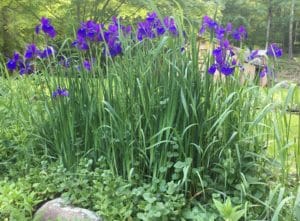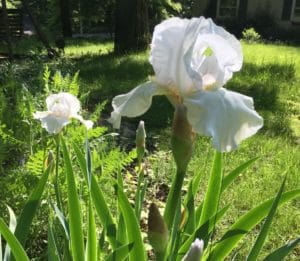Hello, fellow lovers of all things green. I look forward to when the Siberian Iris, planted by the previous owner, emerges in the rock garden and flourishes with deep purple flowers in late spring or early summer. But they have not had nearly as many blooms in the last few years. The same is true of the fragrant white Bearded Iris given to me by my dear friend and design colleague Marty Carson. Yes, dividing them is long overdue.
Somehow, Iris looks like a dainty sort, hence why dividing them seems intimidating. In comparison, Hosta is easy to divide using a small ax to hack the roots apart, which sounds a tad violent, perhaps. But Hosta are quick to recover and are very tough plants. Bambi loves them, though. Thankfully, rotating two favorite natural dear sprays, Deer-Out and Deer-Off, keeps them away. While Irises are deer-resistant, the buds can get nibbled occasionally. So it’s best to spray them when they go to bud.
When to Divide Iris Depends on the Type
The best time to divide them depends on the type of Iris, and while you’ll need to do so with care, it’s not hard. So please don’t let the following “recipe” intimidate you. The method is the same for all irises to maintain plant vigor and prevent overcrowding.
Bearded Iris (Iris x Germanica) are best divided every three to five years. The same is true of our native Blue Flag Iris (Iris versicolor) with similar sword-like leaves I prefer to plant, but why turn down gifted plants as long as they are not invasive? Blue Flag Iris has blue-violet flowers in various shades with lovely veins and pale-yellow highlights. The best time to divide them is late July through August to avoid missing out on the spring blooms. Yay, I’m off the hook for now. Smile.
How to Divide Iris is Universal:
After cutting back the leaves to a third of their height, dig up a clump, then wash off the dirt from the underground stems called rhizomes. Pull them apart by hand or using a sharp knife, ensuring each division has large, firm rhizomes and two to four fans of leaves with each clump.
Toss unhealthy or insect-ridden rhizomes. An iris borer, a stealth pink caterpillar, feeds on the inside rhizomes, often leading to bacterial soft rot. So, squeeze the roots even if they look okay from the outside.
Plant the divides right away. Dig holes the size to accommodate each split, typically about five inches wide and deep, spacing them sixteen to eighteen inches apart, creating a mound of soil in the middle. Sit the rhizome on the mound and spread out the roots.
Irises prefer full sun and well-drained soil, so add compost to clay soil. Cover with soil, keeping each rhizome just below the surface. Water them thoroughly, and avoid adding mulch on top, as this can retain moisture and encourage rot.
Siberian Iris doesn’t need dividing as often as Bearded Iris.
I think the narrow grass-like leaves of the Siberian Iris (Iris sibirica) are more appealing in the garden after flowers are spent than the sword-like foliage of the Bearded Iris. But both are beautiful in bloom.

Along with the gift came a purple surprise :^)
Siberian irises don’t need dividing as often as Bearded irises – another plus, call me lazy (smile.) When they bloom less, have bare centers, and become crowded like mine, it’s time. It’s the same technique as their bearded cousins, though they are deeper rooted. The best time in colder zones like ours is early spring when the foliage emerges. The second-best time is late summer, but no more procrastinating, Mary.
Besides, dividing Siberian Iris takes some muscle to excavate their deep roots. You may need to bring out your garden spade and jump on it around the outside of your clump before digging it out. But hey, it’s good exercise, and being outside is an excellent form of therapy. Plus, dividing and multiplying plants is fun, especially when sharing them with dear friends and neighbors.
Garden Dilemmas? AskMaryStone@gmail.com (and now on your favorite Podcast App.)
There’s more to the story in the Garden Dilemmas Podcast:
Related Podcasts and Posts:
Ep 201. Dividing Perennials and Sharing Growth
Dividing and Sharing Perennials – Blog Post
Ep 47. Personal Growth with Houseplants
Personal Growth with Houseplants – Blog Post




